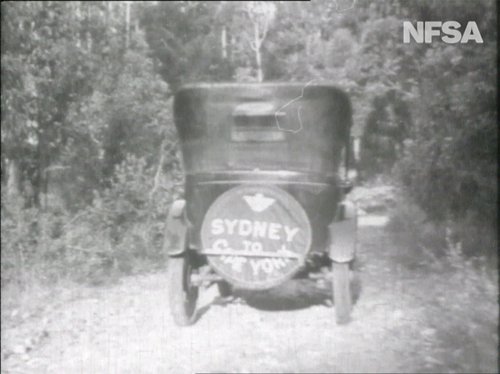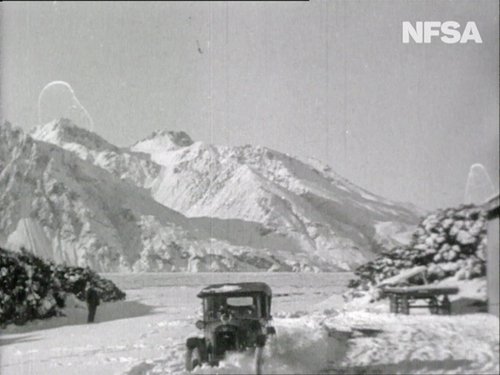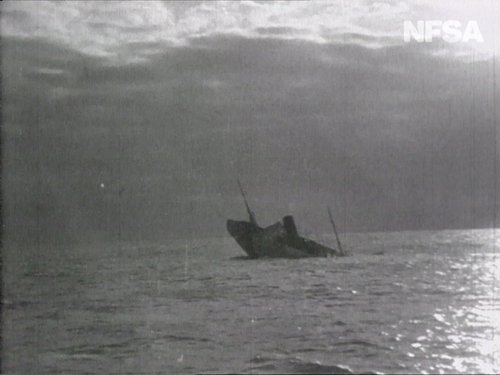
By Jane Paul
Richard B. Mathews (from Kaitaia) and Hector McQuarrie (from Auckland) came to worldwide attention by circumnavigating the globe in a baby Austin. The intrepid kiwis travelled 22,000 miles in their tiny two-seater car, dubbed “A rugged little baby” by Truth newspaper.
Their journey through Australia, New Zealand and on the ill-fated S.S. Tahiti was captured on film by Hector McQuarrie. This extraordinary film can be watched below, courtesy of the National Film & Sound Archive, Australia which holds the original nitrate film:
Around the World in an Austin Seven [Australia and New Zealand], 1928-31, courtesy of the National Film & Sound Archive
Richard (Dick) and Hector’s first adventure was the journey from Sydney to Cape York in Northern Queensland. This marathon trip covered 1,300 miles of which 700 were roadless. Austin (Sydney) supplied the “baby” and in return received paramount publicity for their car. Over three months the pair drove further than anyone had gone before. The journey was dangerous – what would happen if they ran out of water or petrol, or the car was unfixable? They navigated dense bush and steep terrain, pockets of quick sand, crocodile-infested rivers and even fled forest fires before reaching their destination. Hector estimated that they averaged 25 punctures a day. Dick was both driver and fixer of punctures, he was “very strong, 12 stone, almost 6ft and built like a Russian.” [1]
The men left Sydney in August 1928, the Austin loaded up with a tent, supplies (including benzene) a typewriter, (Hector had been commissioned by the Sydney Morning Herald to write a serial about their adventures [2]) and two books: the complete Shakespeare and Alice in Wonderland. By the time they had reached Cooktown they had abandoned most of their baggage, and slept out in the open on gum leaves, wrapped in a mosquito net. With no benzene purchasable after Cooktown, they relied on the goodwill of isolated station owners to help out. Small amounts of benzene was received – mostly from women who used it to power their irons. They reached Cape York on 31 October 1928.

After a spell at Torres Strait and New Guinea (without the baby) the men prepared to make a trip through New Zealand from furthest north to furthest south, and then leave on the next stage of their world tour. The men re-united with their car, “Emily,” in Sydney (after it was shipped down to Sydney as an exhibition in a car show).
Hector, Dick and Emily sailed on the S.S. Maunganui to Wellington. They spent two months in New Zealand and the film shows the men in Rotorua and near the Chateau on Mt Ruapehu.

While in New Zealand, Hector gave lectures and showed his film of the men’s Australian adventures. Auckland newspapers advertised this lecture at the Civic Theatre:
Hector MacQuarrie – Author, Traveller, Adventurer
Will appear in person at each of the above sessions and give an illustrated travelogue
WHERE WE WENT WITH THE BABY
Bristling with Wit and Humour!
Admission – Matinee Dress Circle 1s 6d, stalls 1s, Evening DC 2s
(Press, vol. LXV1, issue 19991, 28 July 1930)
In August 1930 Hector, Dick and “the baby” boarded the Tahiti in Wellington, expecting to reach San Francisco within three weeks.
On the fourth day of their journey (300 miles from Cook Islands) they were awoken by news from the ship’s crew that:
“the tail shaft has broken, the propellors droped off, the engine room is filling with water, and the old lugger’s sinkin.”
The 128 passengers onboard knew that the vessels Penybryn and Ventura were coming to their assistance but not when they would arrive. They endured an anxious 50 hour wait at sea. The passengers were well aware that if the calm waters turned, and the wind and sea got up, the boat would sink. In the interim, the loudspeakers blasted cheerful dance music and food continued to be served.
The Auckland Star reported “Hector MacQuarrie [MacQuarrie was his chosen literary surname], the Auckland journalist, was a passenger […] and he was able to take some excellent shots of the last moments on board, and the sinking of the ship” [4]
The footage begins with Emily being hoisted on-board at Wellington and scenes of shipboard life. Then the last spectacular images, taken on 18 October 1930, of the liner’s final plunge stern first into the ocean’s depths (taking the baby with it). Hector’s footage was taken from the safety of the rescuing ship – Ventura.

Hector and Dick returned to Auckland. The footage was sold to Fox Movietone (for inclusion in their newsreels) and a negative struck for filmmaker Rudall Hayward, who organised showings of the film in Australia and New Zealand.
By March 1931 the couple were in America, where they purchased another Austin 7 called “Emily H.” Newspaper reports from the time record their only “real mishap was when a rumrunner in Florida charged into them out of the wide and flung the car and the two tourists into the ditch.” Luckily they met an English engineer, who restored the smashed car.
After driving through America, they continued on to Britain, France, Italy, Yugoslavia, Bulgaria, Turkey, Czechoslovakia, Jericho, Bagdad, Babylon and India. Adventures encountered included “being fired at by a Turkish soldier and charged at by an infuriated camel.”
So, where is this footage of these other journeys?
We know Hector didn’t lose his camera on the Tahiti, so he is likely to have continued filming along the way. Is it housed in other film archives? Or do Austin clubs around the world have it? We’d love to hear from you if you have information on these films made in Europe, Middle East and other places.
Copies of Around the World in an Austin 7 are held in Australia, by the National Film and Sound Archive, and in New Zealand, by Ngā Taonga Sound & Vision.
Ngā Taonga Sound & Vision was recently in touch with the Austin Seven Clubs’ Association, UK about the film. Chris Garner, a member of the Austin Seven Clubs’ Archive Team, added:
“We here in the UK are delighted to hear that this particular film has been discovered, remastered and made available to all. Our congratulations to all involved.
This piece of Austin Seven history is very important to us all, especially as material of this nature is rare and brings to life what McQuarrie and his companion’s exploits were like at the time.
In conjunction with what our archive team is doing here in the UK with our collation and digitisation project, the film is yet another piece of the rich jigsaw of Seven material that exists. We know many enthusiasts here will look forward to viewing it.”
References
- We & The Baby. Angus Robertson: Australia, 1929.
- This was later released in a book titled We and The Baby, Press, vol. LXVII, issue 20317, 17 August 1931, p. 11.
- Press, vol. LXV1, issue 19991, 28 July 1930.
- Auckland Star, vol. LXI, issue 212, 8 September 1930, p. 9.
Hector MacQuarrie published a number of additional books:
- How to Live at the Front
- Tahiti Days
- Roving New Zealanders
- Round the World in a Baby Car